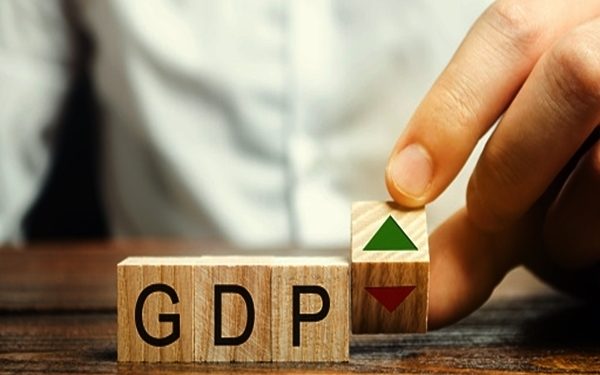Washington: The U.S. Economy shrank from April through June for a second straight quarter, contracting at a 0.9% annual pace and raising fears that the nation may be approaching a recession.
The decline that the Commerce Department reported Thursday in the gross domestic product — the broadest gauge of the economy — followed a 1.6% annual drop from January through March.
Consecutive quarters of falling GDP constitute one informal, though not definitive, an indicator of a recession.
The report comes at a critical time. Consumers and businesses have been struggling under the weight of punishing inflation and higher borrowing costs.
Wednesday, the Federal Reserve raised its benchmark interest rate by sizable three-quarters of a point for a second straight time in its push to conquer the worst inflation outbreak in four decades.
The Fed is hoping to achieve a notoriously difficult “soft landing”: An economic slowdown that manages to rein in rocketing prices without triggering a recession.
Fed Chair Jerome Powell and many economists have said that while the economy is showing some weakening, they doubt it’s in recession.
Many of them point, in particular, to a still-robust labour market, with 11 million job openings and an uncommonly low 3.6% unemployment rate, to suggest that a recession, if one does occur, is still a ways off.
After going backwards from January through March, the U.S. Economy probably didn’t do much better in the spring.
Thursday morning, the government will reveal just how weak economic growth was in the April-June quarter — and perhaps offer clues about whether the United States may be approaching a recession.
The report comes at a critical time: Wednesday, the Federal Reserve raised its benchmark interest rate by sizable three-quarters of a point for a second straight time in its push to conquer the worst inflation outbreak in four decades. The Fed is aiming for a notoriously difficult “soft landing”: An economic slowdown that manages to rein in rocketing prices without triggering a recession.
Forecasters surveyed by the data firm FactSet have estimated that the nation’s gross domestic product — the broadest measure of economic output — eked out a tepid annual gain of 0.8% last quarter. Modest as it would be, that would amount to a sharp improvement over the economy’s 1.6% contraction in the January-March quarter.
Still, quarterly growth that sluggish would represent a drastic weakening from the 5.7% growth the economy achieved last year.
That was the fastest calendar-year expansion since 1984, reflecting how vigorously the economy roared back from the brief but brutal pandemic recession of 2020.
Some economists fear that GDP actually shrank again from April through June, delivering the back-to-back negative quarters that constitute an informal definition of recession. The Federal Reserve Bank of Atlanta’s running estimate of GDP growth, based on available economic data, is signalling a 1.2% second-quarter decline.
Most economists, though, point, in particular, to a still-robust labour market, with 11 million job openings and an uncommonly low 3.6% unemployment rate, to suggest that a recession, if one does occur, is still a ways off.
For one thing, the first-quarter economic contraction wasn’t as alarming as it looked. It was caused mainly by factors that don’t reflect the economy’s underlying health: A wider trade deficit, a consequence of Americans’ keen appetite for foreign-made goods, slashed 3.2 percentage points from first-quarter growth. And a post-holiday-season drop in company inventories lopped off an additional 0.4 percentage point.
The strength of America’s job market, Fed Chair Jerome Powell said at a news conference Wednesday, “makes you question the GDP data.”
The economy posted some encouraging news Wednesday: June reports on the trade deficit (narrower), inventories (higher) and orders for high-priced factory goods (better than expected) suggested that second quarter GDP might turn out to be stronger than previously feared.
Economists at JP Morgan have doubled their forecast for April-June growth to an annual pace of 1.4%.
Even so, recession risks are growing as the Fed’s policymakers pursue an aggressive course of rate hikes that, while they may ease in the months ahead, will likely extend into 2023.
The Fed’s hikes have already led to a doubling of the average rate on a 30-year fixed mortgage in the past year, to 5.5%. Home sales, which are especially sensitive to interest rate changes, have tumbled.
Some economists have echoed an observation Powell made at his news conference Wednesday: That the economy, looked at as a whole, does not appear to be in the grip of recession.
“We do not think the economy is in recession at present,” Tim Quinlan and Shannon Seery, economists at Wells Fargo, wrote this week.
Quinlan and Seery estimated that GDP expanded at a glacial 0.2% annual pace in the April-June quarter — “a harbinger of worse to come as we are forecasting the economy to enter a mild recession early next year.”
Even if the economy does record a second straight quarter of negative GDP, most economists would not regard it as signalling a recession.
The definition of recession that is most widely accepted is the one determined by the National Bureau of Economic Research, a group of economists whose Business Cycle Dating Committee defines a recession as “a significant decline in economic activity that is spread across the economy and lasts more than a few months.”
The committee assesses a range of factors before publicly declaring the death of an economic expansion and the birth of a recession — and it often does so well after the fact.
AP






































